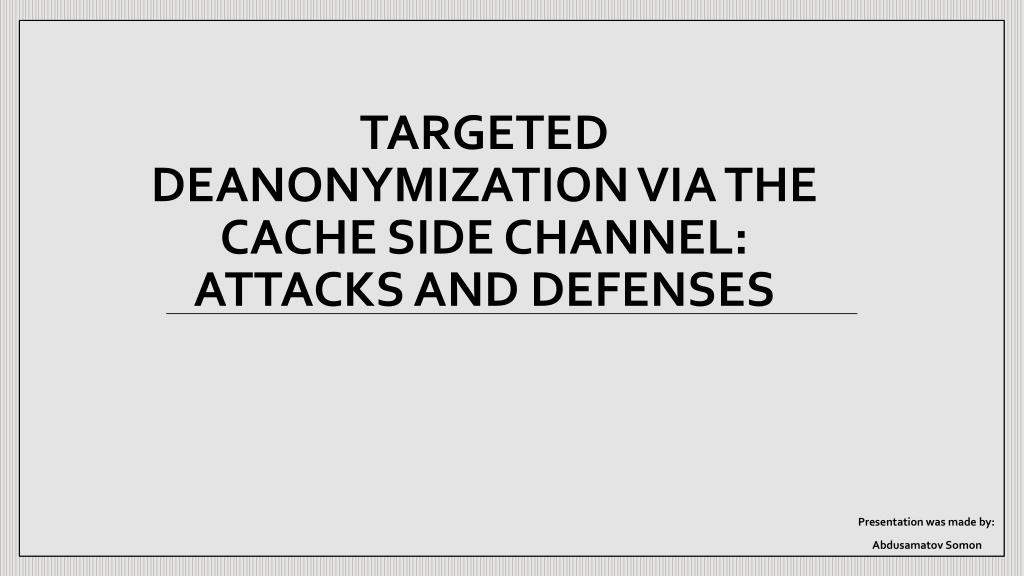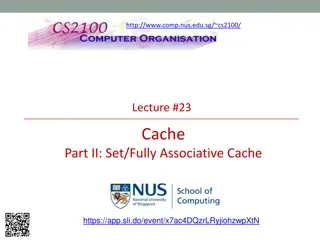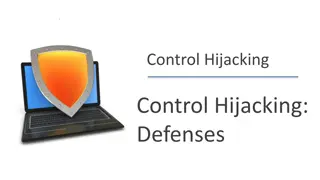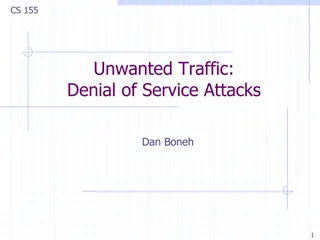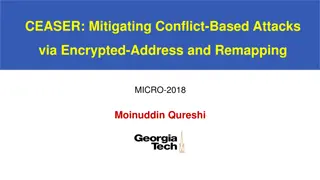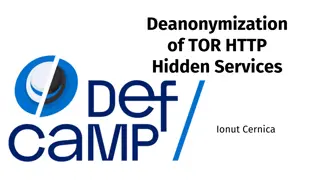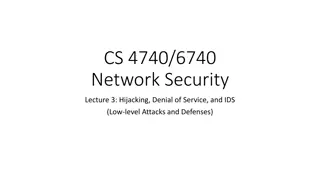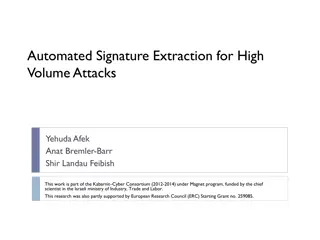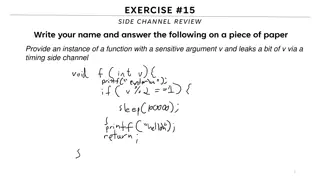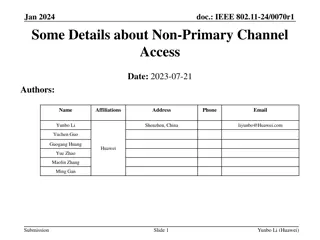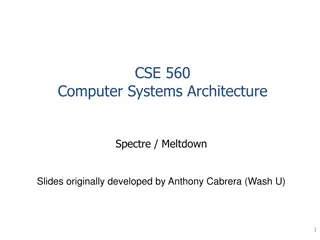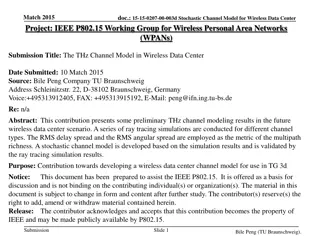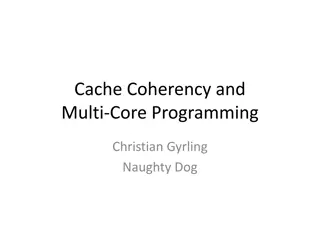Targeted Deanonymization via the Cache Side Channel: Attacks and Defenses
This presentation by Abdusamatov Somon explores targeted deanonymization through cache side-channel attacks, focusing on leaky resource attacks and cache-based side-channel attacks. It discusses the motivation behind these attacks, methods employed, potential defenses, and the evaluation of such attacks. The presentation sheds light on the implications of compromising anonymity online and highlights the techniques used by attackers to deanonymize high-profile targets.
Download Presentation

Please find below an Image/Link to download the presentation.
The content on the website is provided AS IS for your information and personal use only. It may not be sold, licensed, or shared on other websites without obtaining consent from the author. Download presentation by click this link. If you encounter any issues during the download, it is possible that the publisher has removed the file from their server.
E N D
Presentation Transcript
TARGETED DEANONYMIZATIONVIA THE CACHE SIDE CHANNEL: ATTACKS AND DEFENSES Presentation was made by: Abdusamatov Somon
Plane Motivation & Problem Method Attack Defense Evaluation Conclusion
Motivation On the Internet , everybody knows it is better to stay anonymous. Targeted deanonymization attack the goal of this attack is compromise a high profile target Consider the case where a law enforcement agency has covertly taken control of an underground extremist forum. The agency wishes to identify the users of this forum, but these users use pseudonyms to connect to the forum.
Method Leaky Resource Attacks Leaky resource attacks are targeted privacy attacks, which can uniquely identify an individual browsing an attacker-controlled webpage. The attack consists of two phases Setup phase There are two approaches to perform this binding. Sharing-based approach (the attacker privately shares the resource with the target by using the victim s email address ) Blocking-based approach (the attacker makes the resource public, and then blocks the target from viewing any resources owned by the attacker).
Leaky Resource Attacks In the execution phase Steps 1 and 2 he attacker causes the target to visit this page Steps 3 and 4 as the target s browser renders the page, it makes a cross-site request for the embedded resource to the sharing service Step 5 with the sharing-based approach, the response to this cross-site request contains the shared resource if the user is the target, and an error otherwise. Step 6 learning information about the response. The leaky resource attack (sharing-based approach).
Cache-Based Side Channel Attacks Micro-architectural side-channel attacks Exploit deeper processor ingredients below the trust architecture boundary Cache side-channel attacks This attack is one type of micro-architectural attack. There are several methods for performing cache attacks. This work uses the Prime+Probe technique. The Prime+Probe attack has four steps. First, the attacker creates one or multiple eviction sets. In the second step, the attacker accesses the eviction set, bringing the cache into a known state (prime step) Next, the attacker waits for the victim to use the cache. In the fourth and final step, the attacker accesses the eviction set again
Attack General Attack Methodology The attack has two phrases Training phase and an online phase In the training phase: The attacker trains a machine learning classifier to detect the cache signature associated with successfully loading a leaky resource. In the online phase: In the online phase, the victim visits the attacker controlled page, which loads the leaky resource. While the leaky resource is loaded and rendered, the attack page measures cache activity on the victim s computer. Finally, the attacker passes the collected cache measurements through the trained classifier, allowing it to identify the victim
Embedding methods: The first method is iframe approach The attack web page initiates the cache activity measurement (line 1), uses JavaScript to insert an <iframe> tag and load the leaky resource inside it (lines 2-4), takes cache measurements for the duration (line 5), and finally removes the <iframe> (line 6) and uploads the traces to the server (line 7). Second method is pop - under Embedding method: iframe The go() function, executed on user click, starts cache activity measurement (line 2), and then opens a new pop-under window to load the leaky resource (line 3). The attack page, which is in focus, takes cache measurements while the leaky resource is loaded in the pop-under window (line 6). Once the measurements are collected, the pop-under window is closed (line 7). Embedding method: pop-under.
And the last method: tab-under The go() function, which runs upon user click, opens a second instance of the attack page, with an added URL parameter (lines 2-3). The focus is now on this second instance, which looks identical to the first instance, so this action is barely noticeable by the user. The second instance of the attack page now starts collecting cache measurements (lines 5-8). Meanwhile, after opening the new tab, the first instance of the attack page, which is now in the background, navigates to the SD- URL of the shared resource (line 4). Since the first tab is not in focus, the victim does not notice the leaky resource being loaded in this tab. Embedding method: tab-under
Attack Attack accuracy: 84.5% - 100% Time: Less than 3 seconds (and up to 10 seconds) Systems: Browsers: Services: Authors successfully execute the attack on browsers which has a strict policy of not allowing cookies to be attached to crosstalk requests including Safari and Tor.
Summary of experimental results. Attack accuracy (%) is shown both before and after applying Leakuidator+. ta is the attack duration in seconds. Scalable attack results for 8 user states. Attack accuracy (%) is shown both before and after applying the Leakuidator+ defense. ta is the attack duration in seconds.
Defense: Leakuidator + Interaction Diagram for Leakuidator+.
Evaluation Authors performed a comprehensive set of experiments to validate Leakuidator+ s effectiveness. With Leakuidator+ attack accuracy becomes equivalent to that of a random guess. Authors also evaluated Leakuidator+ s effectiveness against attacks targeting a group of users. In this case attack accuracy becomes 12.5%.
Future Work As future work, Authors plan to further explore and improve usability aspects of the proposed Leakuidator+ defense.
Conclusion In this paper the authors introduced us a novel attack techniques for targeted deanonymization on the web, which can uniquely identify a target user when leaky resources are rendered in the user s browser. They also present us group attack. And finally Authors present us defense against those threat. Leakuidator+ is a client-side defense that can be deployed right away as a browser extension
Thank you for your attention! Any questions ?
